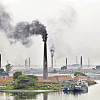When breathing is taxing: Pollution in Dhaka Udyan, Mohammadpur Beribadh

The dry winter season leads to deteriorating air quality across the capital, especially the outskirts of the city where the seemingly perpetual government and private construction and emissions from unfit vehicles release pollutants into the air.
These factors have left residents of Mohammadpur Beribadh and Dhaka Udyan dealing with a serious air pollution crisis.
What health risks are posed by these environmental conditions? And how are citizens coping with these challenges?
Dhaka has consistently ranked among the top five cities with the worst air quality in the world this winter, with the capital taking the unwanted top spot on several occasions.
When this correspondent visited the areas on November 7, he observed that road expansion work was ongoing on both sides of the road, leading to the pervasive presence of dust and deteriorating air quality.

Additionally, there were bricks, sand, and brick chips strewn on both sides of the road, exacerbating air pollution and causing health issues – especially respiratory problems – for commuters.
Humaira Mansur, a student at University of Liberal Arts Bangladesh who resides in Dhaka Udyan, disclosed that she has developed respiratory problems over the past year due to the situation in the area.
"I had no breathing problems before moving from Uttara to this area a year ago. However, after consulting a doctor, I was identified as having respiratory issues. I am now considering leaving the area," she shared.
Rafiqul Amin, a banker working at a private bank, voiced his worries regarding the dusty road during rush hour.
He stressed that the air in the area has become so laden with dust that it appears foggy.

Nahian Jamal Joyeeta, another ULAB student who has been commuting to the area on a regular basis for the past four years, expressed similar sentiments.
"Since childhood, I have dust allergies, sinus and asthma. My asthma hadn't relapsed for a long time until I started coming to this area. It has worsened after Covid-19 since road constructions and volume of vehicles has increased," she said.
Several residents of the area echoed similar sentiments, expressing frustration with the authorities for ignoring the problem for the past three years.
Dr Ahmad Kamruzzaman Majumder, Dean of the Faculty of Science at Stamford University Bangladesh and Chairman of the Center for Atmospheric Pollution Studies (CAPS), pointed out that their research identifies this spot as one of the most polluted areas in Dhaka city.
"I visited the area a week ago and found the same issue," he said.

According to him, 70 percent of the pollution in the area results from black smoke emitted by unfit vehicles and dust from the roads. Ongoing government and private construction projects are responsible for the remaining thirty percent.
In the interim, he suggested frequent road watering to reduce pollution, and he recommended that road repairs be made as a permanent solution to the issue.
As for residents and commuters, they have to resort to whatever methods they need to manage their ailments. Nahian Jamal Joyeeta describes her regimen, "Wearing a mask is the best option if I'm outdoors. I also carry my emergency medication with me such as inhalers, anti-histamines and nasal sprays. Additionally, I use hand sanitisers, and also carry a change of clothes in case my clothes get too dusty – it prevents further allergic reactions."

 For all latest news, follow The Daily Star's Google News channel.
For all latest news, follow The Daily Star's Google News channel. 









Comments